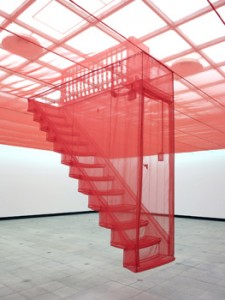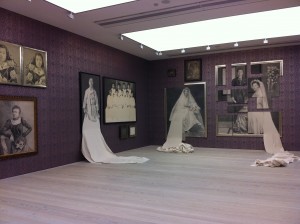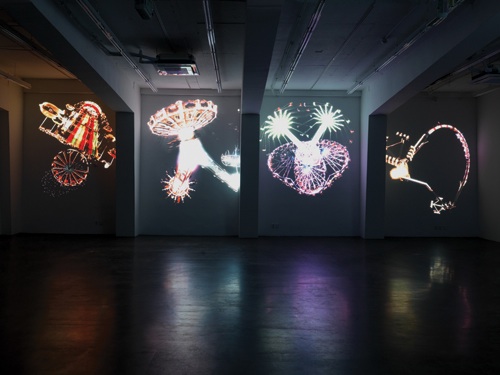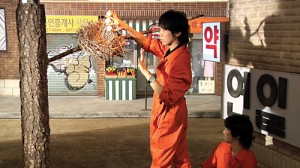All Eyes on the East
As next week I’ll be heading off to Gwangju, South Korea to participate in emergent art fair art:gwangju:12 and to take a peek at the host of delights featuring in this year’s Gwangju Biennale it seems apt to pen a few thoughts about Korean art.
Between Tradition, Modernity and Globalisation
A couple of months ago I attended an insightful symposium looking at contemporary Korean Art organised by the Courtauld Institute and organisers of art:gwangju:12, SUUM Global Curatorial Office. This conference felt timely in light of the increased profile Korean artists have received since Korea began participating in the Venice Biennale in 1995, and the burgeoning art market in China over the last couple of years.
If asked to name a Korean artist most people would be able to name check Nam June Paik, whose seminal video works continue to be shown at major museums and galleries. Paik is also memorialized with an annual award at Kunststiftung NRW, Dusseldorf, the city where he spent 10 years teaching, and with a prize bestowed by the
Nam June Paik Art Centre in the Gyeonggi Province of Korea, which was won by Doug Aitken this year on the 80th anniversary of Paik’s birth.

Having gone to the conference assuming I knew nothing of Korean art, I was soon reminded of other prolific Korean artists work that I’d seen in the UK. Lee Bul’s sublime cyborgs, Kim Sooja’s Needle Woman video installation, and Do Ho Suh’s vivid staircase installation in the Hayward Gallery’s playful Psycho Buildings exhibition in 2008.
Although I didn’t see every presentation over the three days, from what I witnessed there were some engaging presentations. Speakers spoke on the influence of philosophy and Eastern spiritualism on the work of Nam June Paik and Lee Ufan, with its influence felt still in the work of contemporary artists such as Debbie Han. Talks followed on the US modernism influence on Korean artists in the 60s and 70s where art moved on from the folk art and woodcuts of the 50s, and there was a prevalence of monochrome and abstract work by the likes of Park Seo Bo and Seung-Won Suh.
It was interesting to hear how Korean artists from the 1930s onwards migrated to Europe to study and to connect with art movements abroad. This included painters Wolryong Byon and PoW survivor Lee Qoede, whose work was not discussed back in Korea till the eighties, but both are celebrated there now. And similarly during a panel discussion it transpired that owing to the suppression of the media and academia, ordinary Koreans were not aware of the international success of artists like Nam June Paik until the eighties, at a time when Paik was experimenting with televisual broadcast with Good Morning Mister Orwell in 1984.
There was also discussion around works that addressed the political issues in Korea in a more direct fashion, with radical performance art. Korean Avant Garde Association artist Kang So Lee was cited, who made work where extreme limitations were placed on the action, such as tying a live chicken down in a circle of earth to comment on the restrictions imposed by the Korean government. Such political performance usually took place at art fairs rather than in public spaces. Though it appeared that the establishment was not keen on such artists being seen to represent Korean art.
Investigations around Korea’s relationship to the West, cultural difference and imitation of Western art were also considered. Artist Charlie Hahn, who works in photography and time-based media, questions identity and culture in his work; in his film ‘You Talkin To Me?’ cuts together footage of the artist miming along to famous American quotations. As well as Bahc Yiso, who represented Korea at several biennials with anti-heroic works that attempted to avoid readings of race or politics as would be expected in representing the nation of Korea.
A few artists were present to speak on their practice at the symposium, and it became apparent that craft and process were primary concerns of Korean artists. Cho Duck Hyun presented projects that interrogated ideas around collective memory. His ‘excavation’ projects create fictional scenarios where the artist digs up an area, buries sculptures, and then excavates the sculptures, creating memorials to fictional, historic events. He even went so far as to create a video for his Asian Art Museum show where the museum staff gave testimonies to the discovery of the sculptures as if it were a real archeological find.
The conference ended with a presentation by Yeondoo Jung, a hip, young artist, with the sensibilities of Michel Gondry. To show the imagination of the artist, his most recent work, Documentary Nostalgia, is an 84 minute single-shot piece. Filmed in the exhibition hall of National Museum of Contemporary Art, Korea, for the entire 84 minutes the sets are moved in and out of shot by a crew. You can watch clips online here. He has also made people’s dreams come true by staging photographs of ordinary people’s desires and by recreating children’s drawings of princesses and fairytales.
Saatchi Gallery
I also recently visited Korean Eye 2012 at the Saatchi Gallery, London. For an overview of what’s happening in Korean contemporary art, it’s certainly worth checking out this free exhibition. Of the 33 artists on show I particularly appreciated Debbie Han’s manipulation of the bust of Venus in ‘The Battle of Conception’, Bae Joonsung’s lenticular pictures featuring a mix of classical paintings and nude females, and Je Baak’s video installation where footage of fairgrounds and fireworks are collaged to make an other worldly scene.

Plus, harking back to the conference, there’s a great installation of Cho Duck Hyun’s Nora Collection featuring photo realistic renderings of found photographs of Korean families and fashion designer Nora Noh.
And there’s a fantastic display of Meekyoung Shin’s Translation Vases, which are incredibly beautiful and well-crafted creations made out of an unexpected material (soap). It’s on till 23 September, do check it out.
Korean Art elsewhere in London
As it’s currently the All Eyes on Korea: 100 Day Summer Festival you can take in a wealth of Korean culture in London, including an exhibition of Korean Funerary Figures at the Korean Cultural Centre UK. At the Southbank Centre, you can see artwork by Korean artist and designer Choi Jeong Hwa who uses mass produced baskets to transform the concrete pillars of the Southbank Centre for his work Time after Time, until 9 September. And there’s Kim Beon is in exhibition in the Hayward Gallery Project Space just round the corner. Meekyoung Shin appears again, having created a sculpture in her favourite material (soap) for Cavendish Square that over a course of a year will be eroded by the rain, do check it out whilst it’s still visible.
It’s worth taking note of the art coming out of Korea for the wealth of experimentation, skillful delivery and beauty that can be seen in the works I’ve mentioned above. Now for the culture that awaits in South Korea…

